





SOUTH-WESTERN OREGON

Four Days in May - Day Two
Sunday, May 24, 2009. The Klamath Basin.
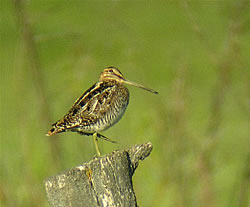 It’s about fifty miles from central Ashland to the western shore of Klamath Lake. Again we left at 6.15 am. We would tick more than 90 species for the day, driving our two-day total to almost 120. Pretty fair as we had foregone some easy-to-find birds that would duplicate what Bay Area birders can easily see near home: Oak Titmouse, Ash-throated Flycatcher, Hutton’s Vireo, White-crowned Sparrow, California Towhee, Wrentit, Red-shouldered Hawk. It didn’t seem to matter that few of the group saw a Downy Woodpecker or Kestrel on this trip. However, the dearth of Kestrels is a matter of conservation concern, far beyond list-building.
It’s about fifty miles from central Ashland to the western shore of Klamath Lake. Again we left at 6.15 am. We would tick more than 90 species for the day, driving our two-day total to almost 120. Pretty fair as we had foregone some easy-to-find birds that would duplicate what Bay Area birders can easily see near home: Oak Titmouse, Ash-throated Flycatcher, Hutton’s Vireo, White-crowned Sparrow, California Towhee, Wrentit, Red-shouldered Hawk. It didn’t seem to matter that few of the group saw a Downy Woodpecker or Kestrel on this trip. However, the dearth of Kestrels is a matter of conservation concern, far beyond list-building.
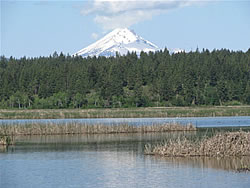 Stops along Dead Indian Road before we reached Howard Prairie provided good looks at Lazuli Bunting males and Western Tanager. The roadside at Howard Prairie yielded our only good views of a single posted Wilson’s Snipe, recorded by Len Blumin’s camera. A brief toilet stop at Lily Glen alongside Howard Prairie Lake gave us looks at the lake birds (pelicans, et al.) plus RB Nuthatch, Mountain Chickadee, Chipping Sparrow and Purple Finch.
Stops along Dead Indian Road before we reached Howard Prairie provided good looks at Lazuli Bunting males and Western Tanager. The roadside at Howard Prairie yielded our only good views of a single posted Wilson’s Snipe, recorded by Len Blumin’s camera. A brief toilet stop at Lily Glen alongside Howard Prairie Lake gave us looks at the lake birds (pelicans, et al.) plus RB Nuthatch, Mountain Chickadee, Chipping Sparrow and Purple Finch.
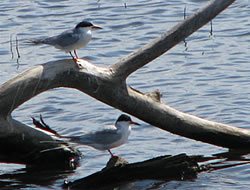 At Eagle Ridge there was a rich menu of waterbirds and landbirds. It’s dry woodland peninsula surrounded by lake on three sides, thumb-shaped. The inside of the thumb is a heavily reeded marsh, perfect for birds who nest on floating vegetation from grebe to duck to tern. Despite the mixed forest our only woodpecker was a Red-breasted Sapsucker. Birds we did catalog: Black and Forsters’s Tern, Gadwall, Ruddy Duck in breeding plumage, Mallard, Redhead (a good Pac Coast bird), Pied-billed, Western and Clark’s Grebe. The Pied-billed were already leading around half- grown young. Raven, Bald Eagle, TV, Osprey, White Pelican, D/C Cormorant, Ring-billed Gull, Coot, Bullock’s Oriole, Wilson’s and Yellow Warbler, endless Western
At Eagle Ridge there was a rich menu of waterbirds and landbirds. It’s dry woodland peninsula surrounded by lake on three sides, thumb-shaped. The inside of the thumb is a heavily reeded marsh, perfect for birds who nest on floating vegetation from grebe to duck to tern. Despite the mixed forest our only woodpecker was a Red-breasted Sapsucker. Birds we did catalog: Black and Forsters’s Tern, Gadwall, Ruddy Duck in breeding plumage, Mallard, Redhead (a good Pac Coast bird), Pied-billed, Western and Clark’s Grebe. The Pied-billed were already leading around half- grown young. Raven, Bald Eagle, TV, Osprey, White Pelican, D/C Cormorant, Ring-billed Gull, Coot, Bullock’s Oriole, Wilson’s and Yellow Warbler, endless Western 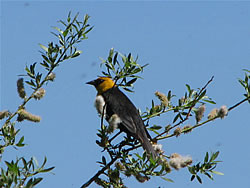 Wood-Pewees, Yellow-headed Blackbirds in the marsh with smaller Red-wings forced to nest on shore. House Wren, Tree Swallow, Chipping Sparrow, Spotted Towhee. At the entrance to Eagle Ridge Road, near Highway 140 we found Fox Sparrow of the gray-headed race. Also, Pygmy Nuthatch found primarily east of the Cascade Ridge in Oregon, not along the coast.
Wood-Pewees, Yellow-headed Blackbirds in the marsh with smaller Red-wings forced to nest on shore. House Wren, Tree Swallow, Chipping Sparrow, Spotted Towhee. At the entrance to Eagle Ridge Road, near Highway 140 we found Fox Sparrow of the gray-headed race. Also, Pygmy Nuthatch found primarily east of the Cascade Ridge in Oregon, not along the coast.
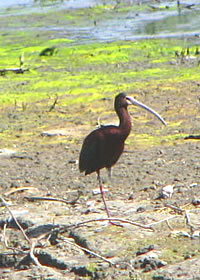 Driving into Klamath Falls from Hiway 140 we passed a wet lakeside meadow with a few dozen White-faced Ibis. A warm-up for birds yet to be seen. A stop at Moore Park failed to find the Red-necked Grebes that had been there a few days earlier. Instead we had numerous breeding plumage Eared Grebe, plus one with white feathers, a leucistic grebe. Many aecmorphorus grebes on the lake, swallows above the waves. Thence to lunch in downtown Klamath Falls where the streets were empty on Memorial Day Sunday. After lunch, south on 97 to Lower Klamath National Wildlife Refuge. My memory is as vague as my notes, but somewhere along US 97 we added Great Egret and Blue Heron, plus a scad or more of Gadwall.
Driving into Klamath Falls from Hiway 140 we passed a wet lakeside meadow with a few dozen White-faced Ibis. A warm-up for birds yet to be seen. A stop at Moore Park failed to find the Red-necked Grebes that had been there a few days earlier. Instead we had numerous breeding plumage Eared Grebe, plus one with white feathers, a leucistic grebe. Many aecmorphorus grebes on the lake, swallows above the waves. Thence to lunch in downtown Klamath Falls where the streets were empty on Memorial Day Sunday. After lunch, south on 97 to Lower Klamath National Wildlife Refuge. My memory is as vague as my notes, but somewhere along US 97 we added Great Egret and Blue Heron, plus a scad or more of Gadwall.
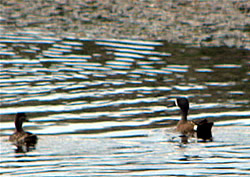 Along Township Road south of Worden we drove east. One roadside canal held several pairs of Cinnamon Teal. Then suddenly several birders in the van called out simultaneously “Blue-wing.” The universal instinct of birders is to use a short-hand when designating an especially prized sighting because time can be crucial. You don’t want to pronounce: “I see a Blue-winged Teal, which, of course, is an unusual bird on the Pacific Coast any time of the year. It’s in the canal next to the Cinnamon.” The two syllable exclamation: “Blue-wing” was sufficient. I slammed on the brakes and we got good looks before they flew to a distant canal. Here (left) is my minimal photo effort. You can see the facial white quarter moon behind the beak of the male bird. The female is your typical little drab dabbling duck.
Along Township Road south of Worden we drove east. One roadside canal held several pairs of Cinnamon Teal. Then suddenly several birders in the van called out simultaneously “Blue-wing.” The universal instinct of birders is to use a short-hand when designating an especially prized sighting because time can be crucial. You don’t want to pronounce: “I see a Blue-winged Teal, which, of course, is an unusual bird on the Pacific Coast any time of the year. It’s in the canal next to the Cinnamon.” The two syllable exclamation: “Blue-wing” was sufficient. I slammed on the brakes and we got good looks before they flew to a distant canal. Here (left) is my minimal photo effort. You can see the facial white quarter moon behind the beak of the male bird. The female is your typical little drab dabbling duck.
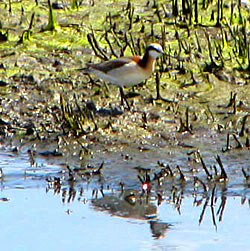 In one flooded field we found our first Wilson’s Phalarope of the day. Also Avocets and a couple Willets in their dark summer plumage.
In one flooded field we found our first Wilson’s Phalarope of the day. Also Avocets and a couple Willets in their dark summer plumage.
Further along the road one field held two huge stick insects, metal irrigation contraptions. In that field: gulls, Ravens, Red-winged Blackbirds and the big ones: Red-tailed Hawks, Swainson’s Hawks, including a nest of three fledglings atop one of the irrigation mechanisms, and a Golden Eagle. He made the Ravens look small, the blackbird almost invisible. We found the weedy canal margins and unplowed fields were chock-a-block with Savannah Sparrows. Most culverts and bridges sustained Cliff Swallows and at least one open-ended pipe had a pair of Northern Rough-winged Swallows.
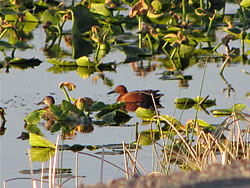 We angled south toward Stateline Road then took it west toward Highway 97 again. More Avocets, Willets, Wilson’s Phalarope, Spotted Sandpiper. Our first Black-necked Stilts of the day. Many more Cinnamon Teal and the Resplendent Glossy [White-faced] Ibises. We saw Lesser Scaup along the previous ducks, then a pair of Shoveler. Then a pair of Canvasbacks.
We angled south toward Stateline Road then took it west toward Highway 97 again. More Avocets, Willets, Wilson’s Phalarope, Spotted Sandpiper. Our first Black-necked Stilts of the day. Many more Cinnamon Teal and the Resplendent Glossy [White-faced] Ibises. We saw Lesser Scaup along the previous ducks, then a pair of Shoveler. Then a pair of Canvasbacks. 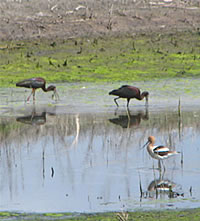 West on Stateline the road dips down into California and thus I missed an Oregon lifer as our only Loggerhead Shrike of the day was perched and hunting in the sagebrush well inside the California border. Looking at Avocets and Ibis side-by-side you realize they have obverse beaks, the upward curve of the Avocet nearly reversing the downward curve of the Ibis. Len Blumin remarked that female Avocets have more extremely curved beaks than males.
West on Stateline the road dips down into California and thus I missed an Oregon lifer as our only Loggerhead Shrike of the day was perched and hunting in the sagebrush well inside the California border. Looking at Avocets and Ibis side-by-side you realize they have obverse beaks, the upward curve of the Avocet nearly reversing the downward curve of the Ibis. Len Blumin remarked that female Avocets have more extremely curved beaks than males.
As we sped northward on US 97 again one of our birders sheepishly admitted he thought he’d seen a swan in the canal. Huh? We dutifully turned around and some got very good pictures of this out-of-season Tundra Swan paddling around a narrow canal like some mere Gadwall. While there is no shoulder on canal-lined 97 around Worden, there is also very little traffic so pictures can be had.
Passing by Klamath Falls we went more than thirty miles further north to Collier State Park on the Williamson River which flows southward into Klamath Lake. There we dipped on Dipper but all was saved by a co- operative Black-backed Woodpecker who zoomed past us and finally allowed us some views. 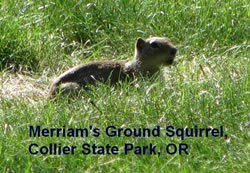 The lawn there was properly plowed in sustainable and organic fashion by Merriam ground squirrels. Named after C. Hart Merriam, long-time head of the U.S. Biological Survey. He became head of that agency when it was founded in 1885 and served until 1909. Then he retired from government service and moved to Northern California where he lived and worked and wrote books on his beloved mammals and Native Americans.
The lawn there was properly plowed in sustainable and organic fashion by Merriam ground squirrels. Named after C. Hart Merriam, long-time head of the U.S. Biological Survey. He became head of that agency when it was founded in 1885 and served until 1909. Then he retired from government service and moved to Northern California where he lived and worked and wrote books on his beloved mammals and Native Americans.
 From Collier we drove northward to Klamath Marsh where we awaited sunset. One Virginia Rail flew into view. Cinnamon Teal were numerous. Even more abundant; wing winnowing snipe. But we did not see a single one. Two elk passed, their heads barely showing above the tall marsh grasses. A Yellowthroat or two could be seen along the edge of pools. As the sun set myth became reality: unseen coyotes howled at the very moment the sun dipped behind the Cascades and the flat-topped form of Crater Lake Mountain became a darker form dominating the horizon.
From Collier we drove northward to Klamath Marsh where we awaited sunset. One Virginia Rail flew into view. Cinnamon Teal were numerous. Even more abundant; wing winnowing snipe. But we did not see a single one. Two elk passed, their heads barely showing above the tall marsh grasses. A Yellowthroat or two could be seen along the edge of pools. As the sun set myth became reality: unseen coyotes howled at the very moment the sun dipped behind the Cascades and the flat-topped form of Crater Lake Mountain became a darker form dominating the horizon.
The Yellow Rail foiled us, an unseen and unheard and still unbelievable presence somewhere, perhaps, in those damp, dense reaches. A quest for another time. We drove back toward Ashland, arriving home not long before midnight.
Checklist
Location: Lower Klamath NWR
Observation date: 5/24/09
Number of species: 38
| Canada Goose | 60 |
| Tundra Swan | 1 |
| Gadwall | 40 |
| Mallard | 20 |
| Blue-winged Teal | 2 |
| Cinnamon Teal | 35 |
| Northern Shoveler | 2 |
| Green-winged Teal (American) | 25 |
| Canvasback | 2 |
| Lesser Scaup | 6 |
| Double-crested Cormorant | 6 |
| Great Blue Heron | 2 |
| Great Egret | 2 |
| White-faced Ibis | 35 |
| Turkey Vulture | 2 |
| Bald Eagle | 1 |
| Northern Harrier | 1 |
| Swainson's Hawk | 4 |
| Red-tailed Hawk | 4 |
| Golden Eagle | 1 |
| American Coot | 50 |
| Killdeer | 4 |
| Spotted Sandpiper | 3 |
| Willet | 6 |
| Wilson's Phalarope | 20 |
| Ring-billed Gull | 150 |
| Forster's Tern | 2 |
| Loggerhead Shrike | 1 |
| Common Raven | 8 |
| Northern Rough-winged Swallow | 2 |
| Cliff Swallow | 65 |
| Barn Swallow | 4 |
| European Starling | 8 |
| Savannah Sparrow | 12 |
| Song Sparrow | 2 |
| Red-winged Blackbird | 18 |
| Brewer's Blackbird | 25 |
| Brown-headed Cowbird | 2 |
(See also the full checklist for all four days)

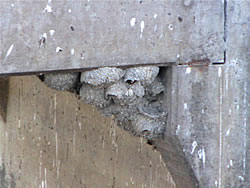
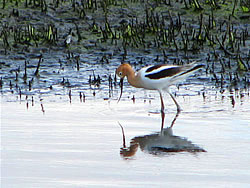
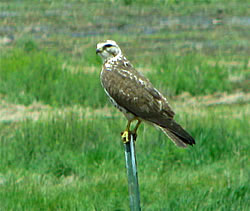
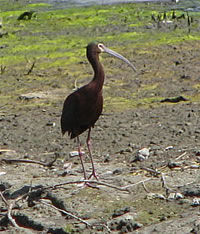
TOWHEE.NET: Harry Fuller, 820 NW 19th Street, McMinnville, OR 97128
website@towhee.net